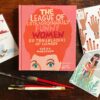Do you dream of having your own home décor collection? Imagine dropping round to a friend’s house for coffee and finding that she’s got mugs that you designed … Or imagine seeing your stunning art on beautiful cushions and throws in a shop and hearing customers exclaim over how lovely they are … Or imagine your fabulous china being picked up and featured in a glossy style magazine. How would that feel?

Work done in class by Lilla’s artist Katie Vernon
Feeling inspired? Our wonderful indepth ecourse, Creating Collections for Home Décor, is self-paced, so you can start right NOW! Created by top art agent Lilla Rogers and trend queen creative director Margo Tantau, it will help you build a professional, market-savvy and downright kickass pitch presentation featuring five of the most popular materials used in home décor. Plus you can currently save 20% on both Creating Collections for Home Décor and our brand new LIVE course, Home Décor Plus, in our amazing Spring Sale – but HURRY! It ends TOMORROW!
Plus if you sign up now, not only will you get full access to all the course materials until December 31st, 2019, but you’ll also benefit from the live review of work from class that Lilla and Margo will be doing this spring exclusively for students in this e-course.

In this newsletter we’re going to give you a little taster session and just dip our toe into some of the insights and wisdom that Lilla and Margo share in the course. We’ll be looking at just one aspect of one of the five substrates which the course covers: finishing techniques for fabric. We’ll be looking at the first two of four finishing techniques included in the full course: stamping and embroidery.
Please note that this is just a taster version of this lesson, which has been reduced in length for this blog. The full lesson contains far more images and boatloads of creative inspiration!
Lesson 2.2: Finishing techniques for fabric
Here’s what so cool about finishing techniques. With this knowledge, you’ll create more than just your basic templated product. You can add these techniques to your artwork that will both inspire you and your client. You’ll stand out.
We will help you understand and learn about different finishing techniques that will add interest and value to your designs. These options will help you to stand out, be creative, and play with this very popular category.

Dishtowels for Anthropologie by Lilla’s artist Tara Lilly. Look at how all three towels work together as a set
Now on to some tips, tricks, and techniques for working with fabric items!
You don’t have to worry about understanding all the methods and technical aspects when you design … just keep in mind what your design can look like in printed form, and be inspired by the techniques below.
FINISHING TECHNIQUES
(1) Stamping
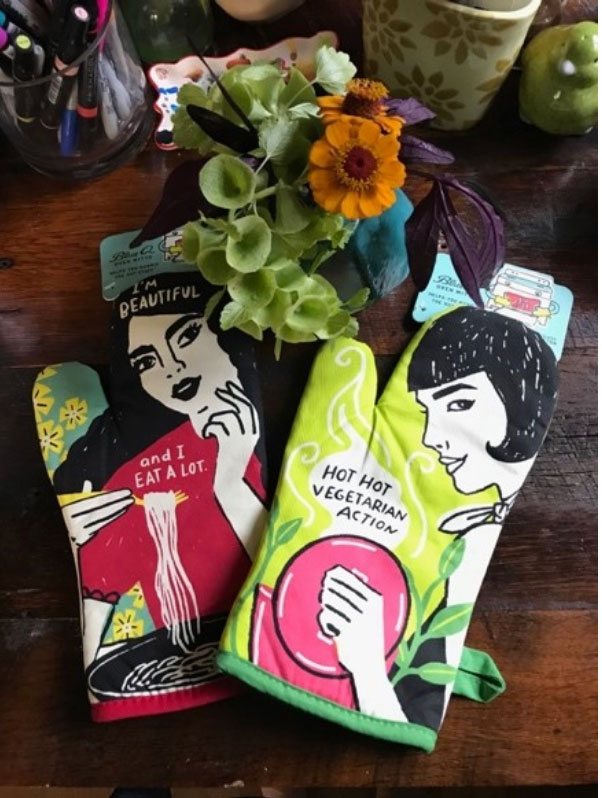
Fabulous oven gloves by Lilla’s artist Anne Bentley. Imagine seeing your kooky unique art on products like this!
First off, let’s learn about how color is printed onto fabric. There are four ways:
- Silkscreen Printing
- Block printing
- Roller Printing
- Digital Printing
Let’s start by looking at limited palettes. Block printing and silkscreen printing are about printing one color at a time. So think about flat color shapes perhaps with texture showing through, like linen or burlap. Here’s how block printing is done:

sometimescrafter.com
Here’s how silkscreen is done. See how the colors are printed one at a time?
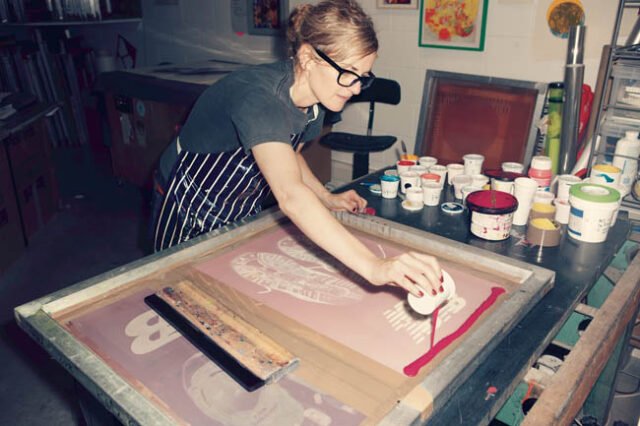
prezi.com
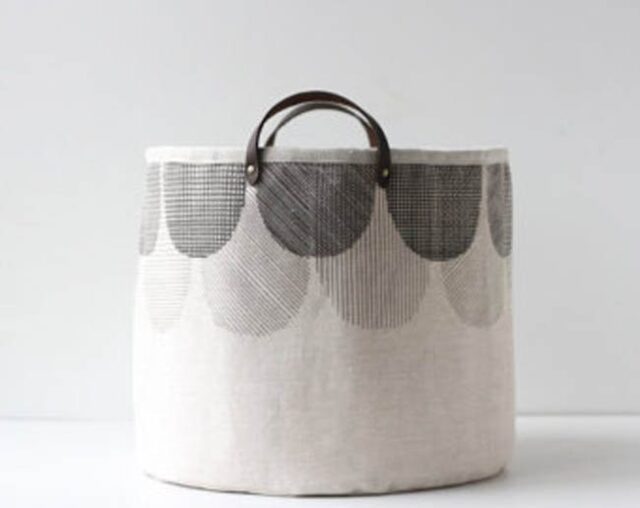
jennarose handmade

Paul Rand fabric
Traditionally the fewer the colors used the more affordable the print, but in today’s world, many colors can be printed digitally. Don’t worry about the number of colors at this point, just know that depending on the production method, it can make a difference.
What YOU should spend time thinking about is how your design translates to the product.
- See how the bucket above is enhanced by the simple design around the top edge?
- How will your design lay out on a tea towel? Will it be hard to see when it is folded in a store?
- If you are designing for a pillow, how would you like your pattern to lay out so it has a visual impact?
All these are important things to consider when you are laying out your pattern.
How do you use this information in your artmaking?

You can make a real stamp and make some stamped items which you then scan in and use on your art.
(Note: Do not use a purchased rubberstamp as you do not have the rights to the image.)

You can replicate the look in Photoshop with filters.
Suggestion: ask our smart Facebook group for ideas on how to do this and suggestions for their favorite filters! (you get access to a private Facebook group full of tips, tricks and a wonderfully supportive community especially for Home Decor students when you sign up for this course)!
Will your client hand-stamp? Not likely, but they can replicate your look!
The charm is that the print isn’t solid and the print isn’t perfect. When one color prints over another, there is some show-through. This is how you can replicate the look in your art.

deschdanja
Next up: Roller printing, also called cylinder or machine printing, is how most commercial fabrics are printed, including bolt fabric (bolt fabric is fabric store fabric. Learn more in MATS A Week 1). Roller printing is like silkscreen in that the colors are flat, but you can print many colors onto the fabric. Generally, it’s limited to about 5 – 8 colors.

Amy Butler
And finally, digital printing is like having a big color copier print on fabric. It allows for halftone shading and can produce photo-realistic quality. It’s great for making your art look amazing! You can do full-color work this way. It’s opened up the world for fabric designers in both home décor, apparel, etc.
Here’s a gorgeous example:

Tricia Guild
To sum up, a few words from Lilla: “Most artists show full-color pieces in their product template presentation. By also showing limited palettes (like a few colors or one flat color) on a product or two, you open up options. So it’s great to show variety! What I mean is, you might show a pillow that is full of loads of colors, and then a table linen that goes with it, but has only one flat color.”
(2) Enhancing with trims or embroidery
We love trims and embroidery! Many products are enhanced with embroidery. It brings to mind a handmade, hand-touched aspect, as well as connecting us to the history of other cultures. It also makes a product just a little more special (and more expensive!)
Below is a pillow showing an all-over embroidered flower pattern. A less expensive option would be to print the floral pattern and just embroider a few blooms.
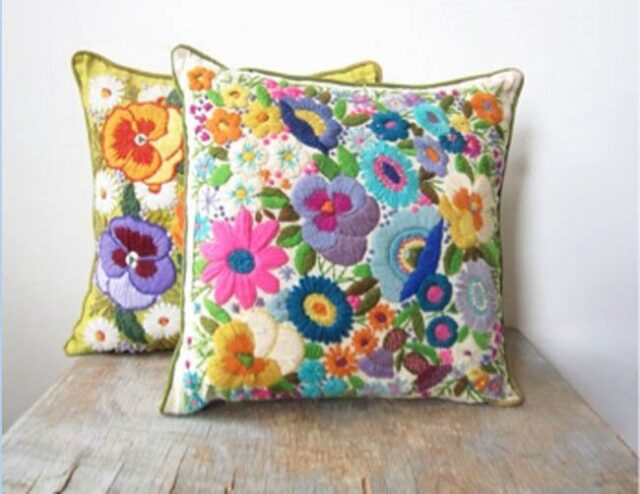
Rust Belt Threads
You can use a little or a lot of trims or embroidery & get great effects. Think of these additions as emphasizing an already printed pattern, as well as standing on their own.
When you embellish or add embroidery over certain areas of a printed pattern, it goes a long way to enhance the art, and add value. It’s like a little treat!
Embroidered pendant shade:

StrayDog Design
“I love how the embroidered word love in white below adds a dramatic but unexpected design element to this piece below. The manufacturer could print the word, instead, for a reduced price option, but you can go ahead and show something like this on your product.” – Margo

plumprettysugar.com
Here’s a stitch sampler that you can use to replicate stitching on your product. How? You could do a little embroidery, scan it in, and place it on your art. Or, you could simply draw the lines to show the idea, and then in your finishing notes indicate that it’s embroidery.

mrspollyrogers.com
You can see from the examples below how a simple shape really comes to life with a bit of embroidery or a trim. Pom poms, ricrac, and ribbon are examples of timeless readily available trims… and running stitch or filled in areas of embroidery are easy to translate to a design.
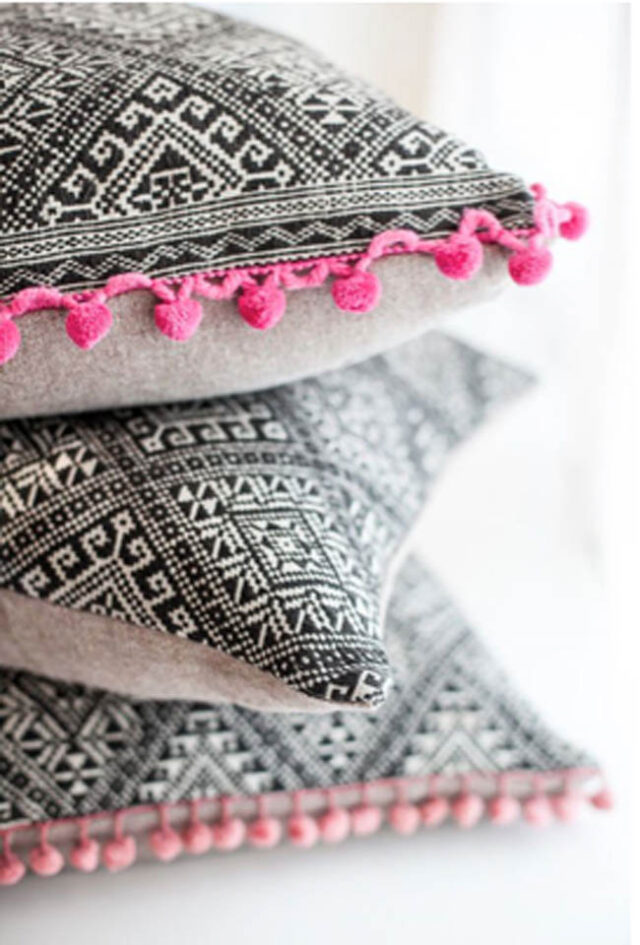
non-perishable goods
So now you are wondering how you suggest these finishing techniques in your artwork, right? Well, Margo advises that you would either show it digitally, draw it, paint it how you want it, or make notes about your ideas. It doesn’t have to be perfect, just give the suggestion.
Hopefully, you are thinking about all sorts of great things that can be done with your designs on fabric. There are lots of references online, and the options are really just as endless as your creativity!
Lilla and Margo xo
***
We hope that you have enjoyed exploring the world of fabric embellishments and have found much to delight and inspire you. This is merely a tiny portion of the kind of information and instruction that you will get in the full Creating Collections for Home Décor course. Plus you’ll get tons of tips and advice on marketing your work, and five fun and motivating assignments to help you to create a full professional home décor pitch. Or if you want the excitement, accountability and motivation of a LIVE class, grab your spot in our brand new ecourse, Home Décor PLUS, now! Don’t forget, they’re both 20% off until Saturday!
Want more? Sign up now and you’ll get instant access to all class materials until December 31st 2019 plus access to the exclusive private review with art agent Lilla and creative director Margo! Join now!
Or alternatively, sign up for our amazing value bundle, My Semester of Art School ALL, and save 35% on Creating Collections for Home Décor, Home Décor PLUS plus a whole host more – click here to download your free copy of our gorgeous sale guide to see everything that’s included. But HURRY – sale ends TOMORROW!
See you in class!
Love
The MATS team xxx



